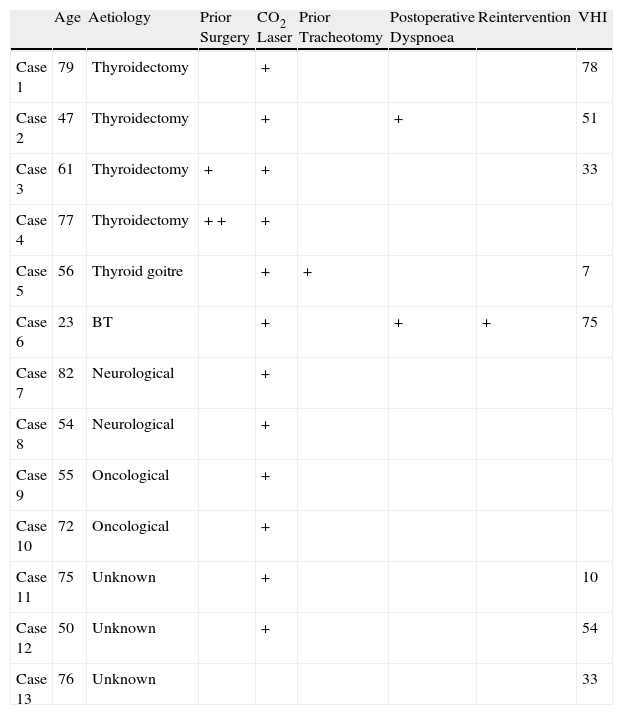Several surgical procedures have been proposed for the treatment of respiratory distress secondary to bilateral cord palsy. We performed a retrospective study of our experience in posterior cordectomy with a laser CO2, analysing the improvement of dyspnoea and voice quality after surgery.
MethodsThis was a retrospective study of 13 cases (9 female, 4 male). The age range was 25–79 years. Iatrogenic post-thyroidectomy (4 cases) was the most common aetiology of bilateral laryngeal palsy in our study.
We assessed the subjective improvement of respiratory function and voice quality after laser surgery using the Spanish adaptation of the Voice Handicap Index (VHI).
ResultsDyspnoea improved in all patients. Two cases had a worsening of dyspnoea in the immediate postoperative period and one case was successfully solved with a new surgical intervention.
After surgery, most of patients suffered from mild or middle dysphonia.
ConclusionsThe posterior cordectomy is an easy, safe, and effective treatment for dyspnoea secondary to bilateral laryngeal palsy, maintaining acceptable voice quality.
La paralisis bilateral en adducción de las cuerdas vocales ocasiona una disnea de intensidad variable, que puede ser tratada con diferentes procedimientos quirúrgicos. Se realiza una revisión retrospectiva de nuestros casos tratados mediante cordectomía posterior con laser CO2, analizando tanto el resultado respiratorio (mejoría de la disnea) como el resultado vocal.
MétodosSe realiza un estudio retrospectivo de 13 casos (9 mujeres y 4 varones) con edades comprendidas entre 25 y 79 años. En nuestra serie la causa más frecuente de la parálisis laríngea bilateral es la tiroidectomía (4 casos).
Se valora la mejoría de su disnea según la opinión subjetiva de los pacientes y la disfonía generada, utilizando la versión española del Voice Handicap Index (VHI).
ResultadosTodos los pacientes mejoraron significativamente de su disnea. Dos pacientes tuvieron que ser ingresados por disnea la primera semana del postoperatorio y uno de ellos fue reintervenido. Tras la intervención la mayoría de los pacientes sufrieron una disfonía leve o moderada.
ConclusionesLa cordectomía posterior es un tratamiento fácil y seguro, que proporciona buenos resultados respiratorios con una disfonía leve o moderada en la mayoría de los casos.








